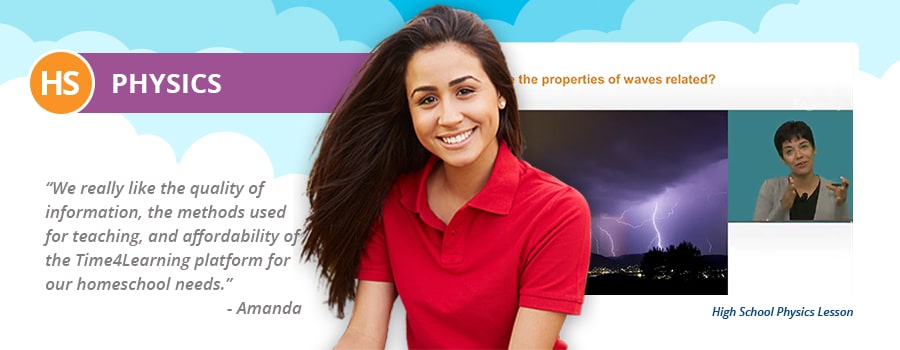High School Physics Curriculum
The physics curriculum is one of three science courses offered at the high school level. Physics is taught using a combination of multimedia lessons, instructional videos, quizzes, tests and both online and offline projects. The physics course is designed to prepare students for college level science.
In high school, physics is usually taught in 11th grade, although some students may take the course in 12th grade or as early as 10th grade depending on their academic level. Students will learn about the basic principles that govern the physical world.
Discover what topics are covered in physics, and how Time4Learning’s online physics course can help your student meet their learning targets.
What Do You Teach in High School Physics?
Teaching physics helps students understand how the universe works, from its structure to how the different components interact with each other. Students explore complex scientific concepts and make real-world connections to understand its impact on daily life.
Our physics curriculum focuses on making sure students get a clear understanding of motion, energy, electricity, magnetism, and the laws that govern the physical universe. Students learn to understand scientific principles and processes, ask questions, present hypotheses, experiment, solve problems, and think abstractly and critically.
Here are some concepts and skills your child will learn through the high school physics curriculum:
- Understanding of the laws and applications of motion, forces, and gravity.
- Understanding of the processes of work and energy and the laws of thermodynamics.
- Understanding of how light and sound waves function in our environment.
- Understanding of principles of electricity and magnetism and how they are applied.
- Knowledge of current achievements and innovative ideas in nuclear and modern physics.
- Ability to use the scientific method to explore physics questions.
- Ability to think critically and abstractly about physics design elements and real-world applications.
- Skills related to the manipulation of equations, graphing, making observations, recording data, and researching.
Learn more about Time4Learning’s physics curriculum by checking out the 11th-grade science lesson plans.
Learning Objectives for High School Physics
At the end of a high school physics course, students should have a strong grasp on concepts of mass, force, motion, energy and more. Additionally, students should have the sufficient knowledge needed for higher level education.
Below are some examples of potential high school physics goals and objectives for your child:
- Use graphs and equations to solve speed and velocity problems.
- Describe Newton’s first, second, and third laws of motion.
- Solve problems using Kepler’s laws.
- Calculate kinetic energy, mass, or velocity given the other two quantities.
- Explain how electromagnetic waves transfer energy by radiation.
- Distinguish between absorption, transmission, reflection, refraction, and diffraction.
- Analyze how light waves bend around objects.
- Use Ohm’s law to calculate voltage, current, or resistance.
- Apply the right-hand rule to determine the direction of the magnetic force on a charge.
- Use the half-life concept to describe the rate of decay of an isotope.
- Identify Einstein’s two postulates of special relativity.
Why Choose Time4Learning’s Physics Homeschool Curriculum?
Time4Learning’s self paced online physics course provides quality education in a user-friendly way. Many families use our curriculum as a supplement to help their students achieve greater success in traditional school, while others use it as their main homeschool curriculum due to its flexibility and rigorous lessons.
As students refine and expand their understanding of physics, they are challenged to apply their knowledge in experiments that require them to ask questions and create hypotheses. Students are also encouraged to design solutions to complex real-world problems through imaginative solutions and more.






